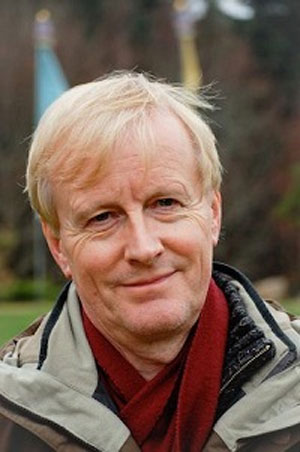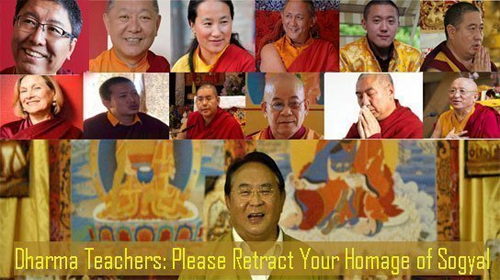Paying Homage to Sogyal Rinpocheby sogyalrinpoche.org
Accessed: 8/31/19
NOTICE: THIS WORK MAY BE PROTECTED BY COPYRIGHTYOU ARE REQUIRED TO READ
THE COPYRIGHT NOTICE AT THIS LINK BEFORE YOU READ THE FOLLOWING WORK, THAT IS AVAILABLE SOLELY FOR PRIVATE STUDY, SCHOLARSHIP OR RESEARCH PURSUANT TO 17 U.S.C. SECTION 107 AND 108. IN THE EVENT THAT THE LIBRARY DETERMINES THAT UNLAWFUL COPYING OF THIS WORK HAS OCCURRED, THE LIBRARY HAS THE RIGHT TO BLOCK THE I.P. ADDRESS AT WHICH THE UNLAWFUL COPYING APPEARED TO HAVE OCCURRED. THANK YOU FOR RESPECTING THE RIGHTS OF COPYRIGHT OWNERS.
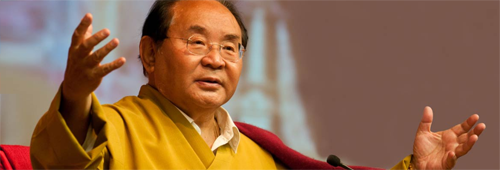 Sogyal Rinpoche was a world-renowned Buddhist teacher from Tibet, recognized as the incarnation of a great master and visionary saint of the nineteenth century, Tertön Sogyal Lerab Lingpa. Sogyal Rinpoche entered into parinirvana on 28th August, 2019.
Sogyal Rinpoche was a world-renowned Buddhist teacher from Tibet, recognized as the incarnation of a great master and visionary saint of the nineteenth century, Tertön Sogyal Lerab Lingpa. Sogyal Rinpoche entered into parinirvana on 28th August, 2019.
Many lamas and friends have sent heartfelt messages and testimonies honouring Sogyal Rinpoche and his accomplishments, and offering their advice and prayers.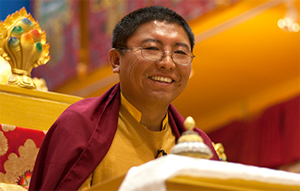 TSOKNYI RINPOCHE
TSOKNYI RINPOCHECondolences to precious mother Mayum-la, sister Dechen-la and the Rigpa Sangha,
We all have heard the sad news about Sogyal Rinpoche leaving his body. Everyone has the right to choose their faith, and based on that faith, there are many traditional practices we can do at this time—practices for ourselves and practices for the teacher.
The essential link between student and teacher is the teaching.
Now, the connection is no longer with the embodied Lama, but rather with the pure dharmakaya Lama. It is a potent time to allow your own unborn nature and the Lama’s dharmakaya essence to mingle together and merge. With that essence as a basis, we can make offerings, supplications, pujas and prayers for swift rebirth.
Also, I want to thank the students and medical team who took care of him at the end of his life, as his physical health deteriorated.
Tsoknyi Rinpoche
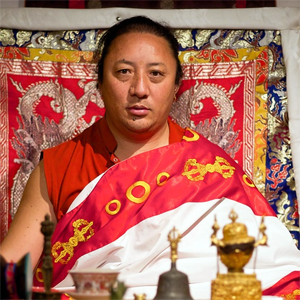 RIGDZIN NAMKHA GYATSO RINPOCHE
RIGDZIN NAMKHA GYATSO RINPOCHETo all my friends, brothers and sisters of the Rigpa sangha from East and West and especially to all the members and staff of Lerab Ling, I Namkha Rinpoche want to say a few respectful words.
Today we have heard the very sad news that
he who was like the eyes in our head and the heart in our chest, for the Buddhist teachings in general, more specifically for the followers of the earlier translation school, the Nyingmapas and even more so for the many thousands of sangha members of the Rigpa centres, the Lord of Refuge Sogyal Rinpoche has passed into Nirvana. It is with immeasurable sadness that I want to express my deepest condolences.
Generally, all worldly phenomena are like an illusion and a dream, so we will all have to follow the same path. However, now, in order to fulfil the enlightened intentions of our precious glorious Lama, to pacify the obstacles of the paths and bhumis and
to quickly see again the golden face of his precious rebirth, I strongly encourage all of you the Rigpa sangha members, no matter who you are, to keep harmony and pure discipline and to diligently create a vast amount of merit during the following 49 days of his passing.
From here, all the members of the different sanghas of the Rigdzin Community and all lamas, tulkus, khenpos and masters who are connected with me, inside and outside of Tibet, will surely make effort in doing aspiration prayers, making offerings, accumulations of merit and practicing virtues activities.
Thus, this was offered by Rigdzin Namkha Gyatso Rinpoche with great sadness at noon of the 28th of August 2019.
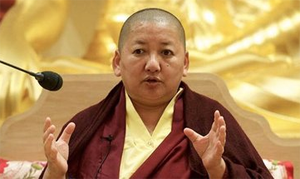 Mindrolling Jetsün Khandro Rinpoche
Mindrolling Jetsün Khandro RinpocheDear Noble Sangha,
It is through the display of the dissolution of the physical body that the Guru bestows the final and one of the most pithy instructions to one' students. But for a student, it can also be one of the saddest and most challenging of times leaving one with feelings of grief, loss and even abandonment. It might feel as if the passing of one’s teacher is like the brilliant sun suddenly disappearing and one encounters such a moment with uncertainty, fear and a sense of being bereft of stability or reference point. However, despite such feelings of loss, this is not the time to let uncertainty, fear and sadness take over. It is at such a time that we also feel an intense and raw connection with the teacher and both death and the teachings come most vividly to mind. We then forge an even more deepened and intimate connection to the teacher from that raw mind that is so tender at the moment.
And from such tenderness, a student's heart opens up and a stream of undying gratitude flows out for the infinite kindness of the Guru and his immeasurable wisdom, compassion and skillful means. Through the joining of this deep gratitude and the Guru's compassionate regard, the Guru's blessings shower upon the student in a continuous amrita stream. With this downpour of blessings, now is the time to once again connect with the heart of the Guru and his teachings with renewed vigor and strengthen the basis of clarity and confidence in the view of the Dharma.
With renewed vigor and confidence in the Three Jewels, when one gives rise to unmitigated devotion to the Guru, we come face to face with the all-pervasive nature of the Guru. I have often thought that the absence of the Guru's physical presence actually allows us to experience the teacher much more pervasively. When the Guru is alive, we tend to think of our Guru as living in a particular place and time. We might think, “Oh, my teacher is in India today and it is 3:00 p.m. there now.” But
when the Guru passes on, we are able to understand that the Guru is actually everywhere, in every moment. In this way, we are able to free ourselves from our own narrow view about the teacher and his physical manifestation and understand the all-pervasive nature just as it is. Through one's passing, the Guru shows us the ephemeral quality of life, time, space and phenomena.
With hearts strengthened by devotion and confidence in the Three Jewels, the blessings of the Guru flow uninterruptedly. For such a heart, anything is possible. And so, with such a courageous heart, with complete faith in the Dharma and devotion to the Guru,
use this time to develop even more steadfastness in your heart and commitment to the authentic teachings of Shakyamuni. As you practice, remember that you are able to understand, practice and accomplish these practices due to the tremendous generosity and dedication of the Guru and that every word and every gesture you make in your practice resonates with the Guru's kindness. And you can only repay that generosity by continuing to practice as deeply and consistently as possible and dedicating one's life to the service of the Three Jewels.
Some of you have asked me as to what prayers and offerings can be made at this moment. There are many things you can do and I am sure many wonderful masters will guide you in this but the best offering that you could make to your Guru at such a time is to come together as a sangha and practice together. Year after year, teaching after teaching, the Guru transmitted the Dharma to you as a sangha with the hope that you would accomplish those practices together as a sangha. There can be no more profound way to honor the Guru than to fulfill this hope and to realize the strength and inspiration that sangha gives us. Now is the best time to make the commitment to continue the practice of the Buddhadharma and to vow that each passing year will only bring about increased study, practice and genuine unfolding of our own innate Buddhanature.
As for prayers, practice Guru Yoga,
remembering that all gurus are gathered within Guru Rinpoche. Recite the Vajra Guru mantra and prayers. Remembering
the indivisibility of one’s teacher with Guru Rinpoche, do Guru Yoga and mantra practice. At this time and in future, come together as a sangha and embody the perfect example of the Guru by practicing together as vajra brothers and sisters fortunate enough to be
united by the golden thread of unbroken lineage, teachings and transmissions from the Guru. Please know that I am sending my prayers to all of you and the entire Rigpa Sangha is ever in my thoughts and prayers. Jetsün Khandro Rinpoche.
***
At this very sad time, like many of you, we have just received the very sad news of Kyabjé Sogyal Rinpoche`s passing into Parinirvana. And
all of us are deeply saddened at this very, very unfortunate time for all sentient beings, to have heard of this very, very difficult news. And all our prayers and thoughts are with you at this time.
Of course, the passing away of one’s teacher is one of the most saddest and challenging of times for all dharma practitioners. It is also during such a time that one’s devotion, and every profound teaching that one has received has to be brought into one’s own mind and practised.
Whenever one’s teacher passes away a meditator and a student experiences a situation which is like the brilliant sun completely disappearing during the daytime. And
during this moment one often encounters a sense of, a moment of uncertainty, and such an uncertainty brings fear and not knowing.It is very important therefore, to turn one’s mind, not just to the extreme loss that one has experienced, and
particularly not letting the fear and the uncertainty and the sadness overwhelm you, but express one’s gratitude for the tremendous blessing and the wisdom and compassion that one has received. And recalling all of the profound teachings, and the devotion in your heart to become the basis of clarity, and even more steadfastness and certainty of the view of the dharma.
Therefore, it is one of the best offerings that we can make is to be together in harmony, turn to the practice, and especially keep in heart the practice of Guru Rinpoche. All of our great teachers, and Sogyal Rinpoche particularly, is gathered within the mindstream of the great Mahaguru, Guru Rinpoche.
Therefore, supplicate to Guru Rinpoche, do Vajra Guru mantras and all of the various Guru Rinpoche prayers and within Guru Rinpoche see the indivisibleness of one’s own guru. And supplicate, and generate devotion. Reciting the Guru Rinpoche mantra, the Guru Rinpoche prayers, particularly the Tsik dun soldep, the Seven Line supplication to Padmakara, as well as continuing with all of your practices. And
doing the Guru Yoga practices will be very, very, I think, helpful for each practitioner.
And as also, express one’s devotion to one’s own Guru, and allow one’s self to really feel the presence of the Guru with you. I have personally often thought that while, when the physical presence of the teacher is no longer with us there is tremendous sadness. But at the passing of one’s own Guru I felt also very much that simply the absence of the physical presence of the Guru somehow made oneself feel even more close and more near, and that the Guru was in every moment, everywhere.
And so therefore, I’m sure that
with your hearts united together in devotion and prayers you will each one of you find Sogyal Rinpoche immediately with you at this very moment. And even more close and more immediate than you have ever felt before.
So please turn to practice. Stay strong. This is a moment where the entire Rigpa sangha needs to be together in harmony and truly embodying perfect example of practitioners and students of
a most wonderful teacher.We all remain with you in our prayers, in our thoughts and we send you all our prayers and blessings, and we hope that each one of you will find strength in your practice.
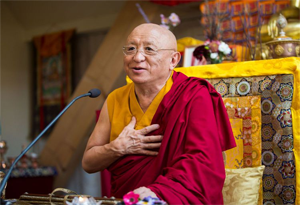 Chökyi Nyima Rinpoche
Chökyi Nyima RinpocheMy sangha and I wish to offer our deepest condolences to Sogyal Rinpoche’s family and the Rigpa sangha for the untimely passing of His Eminence Sogyal Rinpoche.
Throughout his lifetime, he brought the teaching of Buddha Shakyamuni to thousands of people, and established monasteries and Dharma centers throughout the world. Also Sogyal Rinpoche invited many highly realized Rinpoches to give empowerments, profound instructions and reading transmissions. In particular, he provided many students of Buddhism with the opportunity to practice the Dharma intensively during both short and long retreats, which was of great benefit for many students. Therefore, his passing away is a great loss.
Let us make heartfelt prayers that all Rinpoche’s Dharma projects will be quickly fulfilled and that his reincarnation swiftly returns. May his devoted students continue to practice, and may their practice flourish.
Chokyi Nyima Rinpoche from Gomde Pyrenees, France.
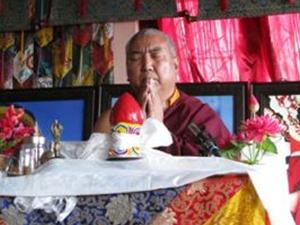 Khenchen Namdrol Rinpoche
Khenchen Namdrol RinpocheA Letter to Comfort and Console the Mind
respectfully written for the international Rigpa Sangha disciples
On August 28th 2019, at the very moment that I heard the sad news of the departure of
the great doctrine upholder, Sogyal Rinpoche, I felt very disheartened. At the same time, I immediately read the Sole Heir of the Doctrine Tantra that Liberates through Contact and the root text on the Great Perfection, the Precious Treasure of the Dharmadhatu, with pure aspirations. My aspirations are that the deceased one fully pacify all obstacles on the grounds and paths and swiftly realize the state of the Primordial Protector, Samantabhadra.
I pray that he may once again benefit the doctrine and sentient beings as limitless as space itself. Whoever is his disciple will certainly feel a sense of deep sadness and loss at this time, for that is the nature of this world of ours. However, that alone will not bring any benefit, so mainly it is crucial to think as follows.
With pure faith and samaya that does not waver, one should give rise to a sense of responsibility to ensure that the legacy of Rinpoche’s vast enlightened activity of bringing benefit to the doctrine and beings in this world will continue to be ever-increasing in the years ahead. Holding this aspiration is the responsibility of all disciples. Please, everyone, bear this in mind.
In addition, I think it is of great benefit for Sogyal Rinpoche’s journey through the grounds and paths, as well as
all disciples’ purification of deteriorations concerning any aspects of samaya, to recite the Stainless Confession Tantra, as well as to chant the one hundred syllable mantra or the concise six syllable mantra as much as possible at this time.
For myself, I will continue as much as I can to offer prayers and present offerings on Rinpoche’s behalf.
Written at Pharping, Nepal on August 29th 2019, Tibetan 2146, on the 29th day of the sixth month by Khenpo Namdrol.
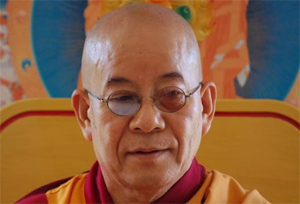 Khenchen Pema Sherab Rinpoche
Khenchen Pema Sherab RinpocheMessage from Khenchen Pema Sherab Rinpoche to all the Rigpa students worldwide
I was saddened to hear of the passing away of Sogyal Rinpoche, receiving the news when I was preparing to travel from India to France. Owing to the above circumstance, I could not send a detailed message to all the Rigpa students at that moment. Now that I have arrived in Paris, I thought I would share my thoughts in a more elaborate way.
First of all, I would like to offer my condolences to all the devoted students of Sogyal Rinpoche, with
his departure from this world into parinirvana. I sincerely share the moment of grief and pain that you all are experiencing now.
When Rinpoche was sick, you all did everything that you could in your own way, in order to see to the restoration of his health—from physically attending to him at his bedside and providing the best possible treatment, to praying for his good health from afar and performing various pujas for his well-being. These efforts show how much you cared for your master and how devoted you are to him.
Even though the demise of the master is heartbreaking, we as practitioners should know that this very event in itself is the greatest teaching of impermanence that the master can provide the students. Even the Buddha left this world, which echoes the most profound teaching: “All conditioned phenomena are ephemeral.” Hence, we should learn from this fact and try to make the best use of our existence.
Sogyal Rinpoche has left behind a wealth of teachings, instructions and guidance for all the Rigpa centers throughout the world, and the time has come for all his students to renew their faith in him and reaffirm their commitment to his messages of love, compassion, wisdom and enlightenment.In order to continue
Sogyal Rinpoche’s enlightened activities and his far-reaching vision for the world and for all sentient beings, all his students should stay united and focused at this critical juncture and take all the necessary measures to ensure that his legacy continues into the distant future for the benefit of all.From the time that Rinpoche was unwell till his last breath, I had been praying for his good health and long life. Even after his passing away, I pray that there is no obstacle to his advancement in the stages of the path to enlightenment.
I also offer my
prayers for all the Rigpa students so that you gain the mental strength to turn adversities into the path and to make your lives meaningful through the study and practice of the Buddhadharma.
With heartfelt wishes,
Khenpo Pema Sherab
Paris
30/8/19
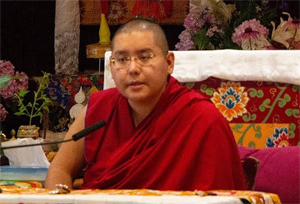 Ling Rinpoche
Ling Rinpoche29th August 2019
Dear Rigpa Sangha, Students and Friends
I would like to extend my heartfelt condolences on the sad passing of your beloved Teacher, Sogyal Rinpoche. I am thinking of you all at this difficult time, and I am deeply sorry for your loss.
Rinpoche knew my predecessor, HH Kyabje Yongdzin Ling Rinpoche, and I feel there is a karmic connection between us which has carried on through this lifetime. I want to reassure you that I am
making prayers for the swift return of Rinpoche, so that He can continue His precious Dharma activities.I have met many of you on my travels to Rigpa centers world wide over the years, and I have been touched by the sincerity and courage with which you have addressed the recent challenges in your Dharma community. It is due to Rinpoche’s kindness that you have had this opportunity to meet the Buddha Dharma, the source of every happiness up to Enlightenment, at this time in the world when the Teachings are so rare. I encourage all of you to make prayers and dedications for the swift return of Rinpoche, and to continue putting into practice the precious Dharma instructions that you have been fortunate to receive.
I offer all of you my blessings and I pray that you will always have the guidance of perfect, pure Mahayana Virtuous Friends, and that all of your dharma activities will be successful.
Kindest regards,
Ling Rinpoche
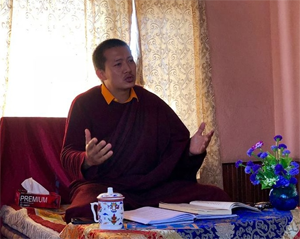 Khenpo Tashi Tseten
Khenpo Tashi TsetenA respectful request to all beloved Rigpa students:
Today I heard that the sublime Khyabje
Sogyal Rinpoche, who has been most exceedingly kind in serving the teachings of the Buddha and sentient beings, has appeared to merge his wisdom mind into the dharmadhatu from the perspective of his disciples who still fixate upon permanence. With respect, I am immeasurably saddened, and I also console you.
However,
even though it appears to us impure students that the master himself has passed beyond sorrow, the inexhaustible wisdom of his enlightened mind never wavers from constantly seeing all sentient beings. So everyone should strive to practice guru yoga, and
merge your own mind with the master’s wisdom mind as much as you can. Since the true nature of mind, a luminous and empty unity, is indivisible with the master’s wisdom mind, there is no better way to fulfil the master’s wishes and perfect your own accumulation of merit and wisdom than the practice of guru yoga. So I kindly request us all to make our best effort to practice this way.
Offered with respect from Namdroling by the khenpo for the Rigpa Shedra in Nepal, Khenpo Tashi Tseten on August 28, 2019.
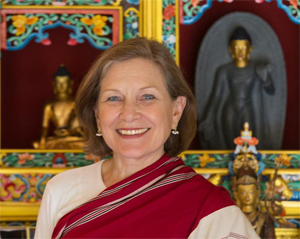 Chagdud KhadroSogyal Rinpoche’s exit from the theater of this life is a sad loss for us as Chagdud Rinpoche’s students, for the Nyingma tradition, and for the Buddha dharma. He was a maestro of activity, an impresario of sacred events, who set a high standard for preservation of teachings and propagation of lineage. He was extremely kind
Chagdud KhadroSogyal Rinpoche’s exit from the theater of this life is a sad loss for us as Chagdud Rinpoche’s students, for the Nyingma tradition, and for the Buddha dharma. He was a maestro of activity, an impresario of sacred events, who set a high standard for preservation of teachings and propagation of lineage. He was extremely kind and supportive of me personally and a good dharma brother to Chagdud Rinpoche. In Tibet their monasteries faced each other on opposite mountains for centuries. In 1987, at one of Sogyal Rinpoche’s dynamic retreats in France, Chagdud Rinpoche said to me, “I felt the presence of Vajra Guru.” After that his loyalty to Sogyal Rinpoche was unshakable.
Sogyal Rinpoche’s devoted students are heartbroken, of course. But, they will find, as we did after the passing of Chagdud Rinpoche, that his presence is not absent.
Like the glow of the setting sun, his transcendent sacred intention will become clearer, more beautifully luminous. They will know it in their hearts.
Chagdud Khadro
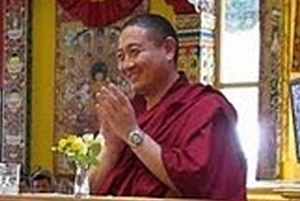 Shechen Rabjam Rinpoche
Shechen Rabjam RinpocheWe are deeply saddened by the news of Sogyal Rinpoche's passing.
Sogyal Rinpoche played a very important role for Buddha dharma in general, and specially for the Nyingma school by
spreading the teachings of Padmasambhava. We feel sorry for this great loss.
As we always talk about impermanence, we should take the passing away of a spiritual master as a teaching for showing us how everything is impermanent.
I request all his students to gather together, practice and to continue to be strong and support his dharma activities.
The Shechen Monasteries in Nepal, India, Bhutan and Tibet will offer lamps and prayers for Sogyal Rinpoche.
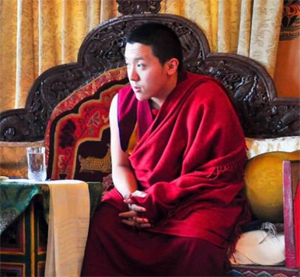 Kyabje Dilgo Khyentse Yangsi Rinpoche
Kyabje Dilgo Khyentse Yangsi RinpocheTo the disciples of Ven. Sogyal Rinpoche
Dear Friends,
I have just received the sad news that, after a long battle with illness, Sogyal Rinpoche has passed away. In general, it is always sad to hear of the passing of
great masters, and this is especially true when you are close to the master who has passed away. It is, nevertheless, simply the way of things.
I feel that when a master is alive, it is essential disciples receive their instructions and teachings with faith and devotion. And, when they pass on, to honour their memory through devotion – our practice and conduct.
I’d like to take the opportunity to remind you of something you will have heard many times before: genuine disciples should be harmonious, have pure, unblemished samaya, and unwavering devotion. This is especially important now - the time of Rinpoche’s passing Sogyal Rinpoche was very close to my predecessor, Kyabje Dilgo Khyentse Rinpoche; from whom he received numerous empowerments, instructions, and transmissions. Personally, I believe that if a connection between master and disciple is strong, it will remain, unwavering.
My connection to Sogyal Rinpoche is very strong. Rinpoche was always very kind and caring toward me, a feeling that is reciprocated. I have always felt very close to and protective of Sogyal Rinpoche, especially so in the recent times of his illness.
Rinpoche requested me to visit him and the centres of his activity – the Rigpa Centres around the world (especially Lerab Ling) – many times. However, due to family commitments – attending and serving my father, Tsikey Chokling Rinpoche – I wasn’t able to fulfil Rinpoche’s wishes and for that I apologise.
I want to request you, the disciples of Sogyal Rinpoche, to be harmonious; to practice the teachings, you have received properly and without hypocrisy; to
be unwavering in your devotion. To supplicate Rinpoche and work to fulfil and sustain all of his activities and wishes. May they all be free of obscuration and obstacle. I will also make prayers and dedicate in the same way.
May the blessings of the Buddhas and Bodhisattvas; of Guru Rinpoche, and all the great masters be with us all.
Yours truly,
Kyabje Dilgo Khyentse Yangsi Rinpoche, Ugyen Tenzin Jigme Lhundrup.
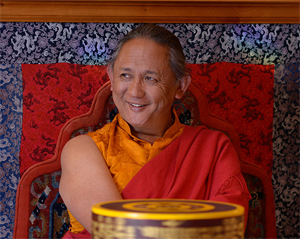 Dzigar Kongtrul Rinpoche
Dzigar Kongtrul RinpocheDear Noble Sangha of Rigpa,
Though it is not traditional to mourn the passing of a teacher in an ordinary way,
I cannot help but feel the magnitude of the loss of Sogyal Rinpoche leaving this planet today. He was a great pioneer in bringing Buddhadharma to thousands in the new world after Tibet lost its independence and many masters had to flee into exile. Ironically, one consequence of this tragedy was the possibility for the Tibetan lineage of Buddhadharma to spread outside of Tibet. Many great teachers like His Holiness Dalai Lama, my own root teacher Dilgo Khyentse Rinpoche, his teacher Jamyang Khyentse Chokyi Lodro, Dudjom Rinpoche, and many others, all went into exile and spread the dharma widely. But the generation of teachers like Chogyam Trungpa Rinpoche, Sogyal Rinpoche, and several others, came to the West. They resided here, formed communities, taught tirelessly, and thus changed the landscape of Tibetan Buddhism in the world.
The loss of Sogyal Rinpoche is the end of an era. Rinpoche had a magnetic persona which inspired great commitment and dedication in his disciples to build communities around the world. These were places where thousands could come together and not only dip their toes in the water of holy Dharma but become truly committed to the practice lineage of Vajrayana Tibetan Buddhism.
I therefore can’t help but mourn the loss of Sogyal Rinpoche and feel deeply for his disciples everywhere, especially at this time. I can only encourage you to carry on with courage and solidarity, to stay on course in the path of Dharma, and to
keep serving the vision of Rigpa with dedication. You have all shown yourselves to be great examples for others to follow in generations to come. I now pray for Rinpoche to be reunited with his own masters, and with the Master of Masters, the Lotus-Born, in the Glorious Copper-Colored Mountain, in one mandala.
I send my thoughts and prayers for the Rigpa Sangha and my deepest condolences.
With Immense Warmth of Tsewa—Love—for You All,
Dzigar Kongtrul Rinpoche
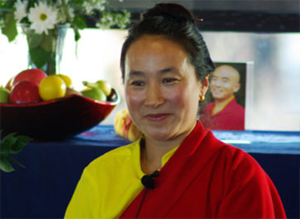 Khandro Tseringma
Khandro TseringmaI am so sorry and sad to hear the news about Sogyal Rinpoche. In his lifetime his disciples served him in the very best way possible.
Now it is time that we all need to pray for His rebirth for the benefit of all sentient beings. Especially pray for Rinpoche’s wishes to serve others and set them in the right direction to achieve Bodhichitta and emptiness. Therefore, all disciples please practice for Rinpoche’s teachings for Bodhichitta and emptiness - this is the best way to fulfil Rinpoche’s wishes and it is also the best way to achieve nirvana ourselves. It is not useful to become sad. I will also pray for His rebirth for the benefit of all sentient beings.
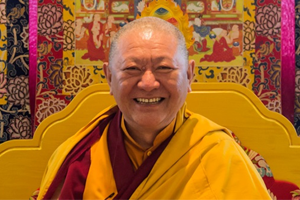 Ringu Tulku Rinpoche
Ringu Tulku RinpocheSogyal Rinpoche: As I Remember
I was deeply saddened to hear the news of the passing away of Sogyal Rinpoche this afternoon, 28th August 2019. I knew him from childhood and he remained a friend to me all his life. I first met him when he was studying in Dr. Graham’s Home School in Kalimpong.
Dr. Graham's Homes (formerly St. Andrew's Colonial Homes) was founded in 1900 by Reverend Dr. John Anderson Graham, a missionary of the Church of Scotland, who settled in Kalimpong and worked with the local community for several years during the turn of the 20th century. Whilst working in Edinburgh as a clerk in the Civil Service, Graham was influenced and encouraged by the Minister of his Church, the Reverend John McMurtrie, to be ordained in the Ministry of God.
-- Dr. Graham's Homes, by Wikipedia
Every weekends and vacations he went to see his Masters and Khenpo’s to study Dharma. He was sent for western education as
he later graduated from prestigious St. Stephan’s College, Delhi, but the deep impact left by Jamyang Khyentse Chokyi Lodro in his childhood never dwindled.
St. Stephen's College is a constituent college of the University of Delhi. Widely regarded as one of the oldest and most prestigious colleges for arts and sciences in India,[2] the institution has produced a line of distinguished alumni.[3] It was established by the Cambridge Mission to Delhi. The college admits both undergraduates and post-graduates, and awards degrees in liberal arts and sciences under the purview of the University of Delhi.[4] As of 2017, the Governing Body of the College has unilaterally initiated a move towards making it an autonomous institution.
The history of St. Stephen's College can be traced to St. Stephen's High School, founded in 1854 by the Reverend Samuel Scott Allnutt, Chaplain of Delhi, run by the Delhi Mission of the United Society. With the closure of Government College, Delhi in 1879 because of financial problems, Reverend Thomas Valpy French, immediately urged the Cambridge Mission, an Anglican mission organised by the alumni of University of Cambridge, to fill the breach.[5] The other major aim for the foundation of the college was response to British Indian Government's policy of promoting English education in India.[6] It was the Reverend Samuel Scott Allnutt of St. John's College, Cambridge, who was mainly responsible for founding the college. Finally on 1 February 1881, in support of the work of the Society for the Propagation of the Gospel, the Cambridge Brotherhood founded the St. Stephen's College. The Reverend Samuel Scott Allnutt served as its first principal.[7]
The Cambridge Mission to Delhi was an Anglican Christian missionary initiative to India in the mid 19th and early 20th centuries led by graduates of Cambridge University. Individual members of the mission community are credited with helping to establish St. Stephens's College, a constituent College of the current University of Delhi, for social reform initiatives, and for providing support in the later years of the Indian independence movement.
The mission was formally established in 1877 under the leadership of Rev. Edward Bickersteth (1850–1897).
In 1877, Rev. Edward Bickersteth a Fellow of Pembroke College accompanied by Rev. John D.M. Murray, of St. John's College set out to India to support the mission work and educational initiatives of the Society for the Propagation of the Gospel.[1] The work of the Cambridge Mission followed in the footsteps of earlier Delhi mission initiatives by the Revd. Midgley John Jennings. Bickersteth and Murray, like many other early participants in the mission were students of the influential Cambridge biblical scholar and Regius Professor of Divinity, Brooke Foss Westcott.
Although Rev. Murray was obliged to return to England early due to ill health, the Rev. H.F. Blackett of St. John's College, the Rev. H.C. Carlyon of Sidney Sussex College and the Rev. Samuel Scott Allnutt of St. John's College all joined the mission in 1878.[2] The mission further expanded in 1879 with the addition of Rev. George Lefroy, who subsequently was assigned Bishop of Lahore in 1899 and later Calcutta in 1912.
With the arrival of a larger group of Cambridge educated Anglican missionaries, Bickersteth moved to establish a more structured residential community for the mission, which came to be known as the Cambridge Brotherhood. This pattern of communal living for unmarried mission clergy was replicated at a later date by Bickersteth in Tokyo, with the establishment of the St. Andrew's Brotherhood on his appointment in 1886 as missionary bishop to Japan.[3]
Among church pastoral initiatives in support of the work of the Society for the Propagation of the Gospel, the Cambridge Brotherhood in 1881 established St. Stephens's College, a constituent College of the current University of Delhi.
St Stephen's Hospital, Delhi was the biggest hospital that was a part of the Cambridge Mission to Delhi. There were several smaller hospitals in the surrounding area that were also associated with the mission. Jenny Muller was the first full-time doctor on staff at St. Stephen's Hospital in Delhi. Marie Elizabeth Hayes, a native a Raheny, Ireland, was another influential medical missionary. As a result of her work on the Cambridge Mission to Delhi, there is a ward in St. Stephen's Hospital names the "Marie Hayes" Ward.
In 1904, Rev. Frederick Western and Rev. Charles Freer Andrews travelled to India to join the mission community and teach at St. Stephen's College. As a close friend and associate of Mahatma Gandhi, Andrews was also later widely known for his work on social reform issues and support of the Indian Independence Movement.
In 1968, the Cambridge Mission to Delhi was formally absorbed into the United Society for the Propagation of the Gospel (USPG), a United Kingdom based registered Anglican charity now known as the United Society or Us [4]
-- Cambridge Mission to Delhi, by Wikipedia
The college's first premises were in Chandni Chowk, Delhi with 5 boarders and three professors, and was an affiliate of the University of Calcutta,[8] but later in 1882, it changed its affiliation to Punjab University. The Punjab University received its charter more than one year after the founding of St. Stephen's College, which became one of the two institutions first affiliated to it and moved into premises in Kashmiri Gate, Delhi.[9]
In 1906, Principal The Rev. G. Hibbert Ware abdicated his post in favour of Susil Kumar Rudra who became the first Indian to head a major educational institution in India. The decision was frowned upon at the time, but Principal Susil Kumar Rudra proved to have a tenure of extraordinary importance for the college.[10]
Reverend C. F. Andrews, a prominent lecturer at the college and member of the Cambridge Brotherhood, was active in the Indian independence movement, and was named 'Deenbandhu' (which means, friend of the poor) by Mahatma Gandhi on account of his work with the needy and with the trade union movement. Currently, a portrait of Reverend C. F. Andrews is hung beside the portrait of his good friend Rabindranath Tagore in the Principal's office. It is also believed that Rabindranath Tagore completed the English translation of 'Gitanjali', for which he was subsequently awarded the Nobel Prize in Literature, while a guest at the college.[5]With the establishment of the University of Delhi in 1922, the college became a constituent college of the University.[11]
Women were first admitted in 1928, as there were no women's colleges in Delhi affiliated with the Anglican Church at the time; after the founding of Miranda House in 1949, women were not accepted as students until 1975.[12]
-- St. Stephen's College, Delhi, by Wikipedia
His confidence in Dharma and his devotion to his Gurus took him to devote all his life to Dharma. He was teaching Dharma to his fellow students in school as well as in University and continued even when
the King of Sikkim sent him to Cambridge University for further studies in UK.His greatest delight was to share what he learnt from his masters that helped him so much.
He succeeded to bring the essence of Dharma to the modern world in an unparalleled way. His book, Tibetan Book of Living and Dying touched millions of people all over the world. I have met people in every nook and corner of the world who told me that his teachings have transformed their lives. He worked tirelessly with his students and he often boasted about how devoted and hard working his students were. He established the Rigpa organisation and succeeded to bring to the West some of the greatest masters of the time.
I have never heard him speak badly about anybody in my life. Even when some of his trusted students attacked him with most serious accusations he did not say one bad word against them. He quietly resigned and left. His only wish was that Rigpa would continue to serve the purpose that he established it for and bring genuine Dharma to the people of this world. He repeatedly asked me to come and teach in its centres and support it to grow. I am sure he asked this to many Lamas and Masters. He soon took ill and passed away. I have lost a true friend who I will never cease to miss.
Ringu Tulku
28/8/2019
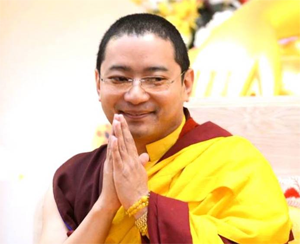 H.E. Khamtrul Rinpoche
H.E. Khamtrul RinpocheKyabjé Khamtrul Rinpoche was
very saddened to hear about the Parinirvana of Terton Sogyal Rinpoche. Rinpoche with Tokden Achoe send theirs prayers and stand with Rigpa community at this time of sorrow.
Rinpoche has instructed Khampagar Monastery, Institute, Dongyu Gatsal Ling Nunnery and Tashi Jong community to hold Lama Chodpa prayers for Terton Sogyal Rinpoche.
Rinpoche’s heart goes to all the Rigpa Sangha and they all are in thoughts and prayers.
© 2018 Sogyal Rinpoche

